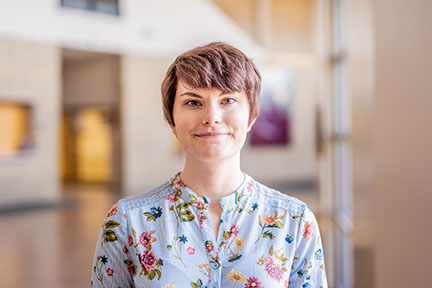Interpreting students. You’ve seen us at convocations, chapels, your own classroom, every campus play and musical, the International Student Coffeehouse, the Round Barn Theatre in Nappanee…the list could go on forever. We are everywhere.
Ever had a friend lean over to you during class and whisper, “Who died?” when you see the way we dress for assignments? I would like to publicly say that we are required to dress in professional clothes that contrast our skin and have no distracting patterns.
Ask any of us what our closets look like and you’ll get responses such as: “Black, charcoal gray, and ash gray. Maybe a dark green or purple if I’m feeling wild” or “I have a nice black blazer and some black fancy pants. Wait, no, Colleen says I need to call them dress pants.”
Maybe you’ve seen us raiding the local Goodwill together for work clothes on a student budget or signing to each other from the second floor library windows down to someone in Schrock Plaza.
What you haven’t seen is the amount of time, work and sheer dedication interpreting requires.
Before convocation or chapel, we scramble to get any preparation we can, which usually involves emailing many people and ending up with nothing but a song title and the order of speakers. Most of the time we get nothing.
Imagine standing on stage in front of the majority of campus and trying to interpret songs (that are often metaphorical and take time to understand the clear meaning) that you’ve never heard before into a completely different language.
We need your speeches, your songs and your bible verses ahead of time. It is our job and passion to provide clear communication for the Deaf community and it becomes difficult when there is no collaboration from presenters.
You haven’t seen us spending hours upon hours of our time on musicals like “Bright Star” and “The Pirates of Penzance.”
Can you clearly interpret “I Am The Very Model Of A Modern Major General” into another language and keep time with it while matching facial expressions of the characters to convey meaning? How about taking on the roles of two different characters at the same time and role shifting between them when they’re talking to each other?
What do you do if one of the characters assigned to you needs to be portrayed as being deeply in love with your team interpreter’s character, but in the next scene you switch characters and suddenly need to show your unbridled hatred for them? It’s important to focus on how the actors show emotion on their face so we can incorporate that into our interpretations.
Also, when we show up for the performance, we don’t know if the Deaf people in attendance use ASL or Signed Exact English, so we have to be prepared to code switch our interpretation on the spot.
When we’re not hard at work on performance interpreting, we are attending workshops all over the midwest. They range from educational interpreting in K-12 settings to how our Myers-Briggs personality types affect how we work with other interpreters and the Deaf community.
We pay out of pocket for every workshop we go to, which racks up quickly when there is a required 15 hours of professional development per semester.
Because we spend so much time with each other at workshops and have small classes of 10 to 12 people, we are very aware of being perceived as a clique.
It’s hard not to spend time with each other when we share the same passion for the language (and have classes together every day), but we aren’t exclusive to the Sign Language Interpreting program. You can find us involved with theatre, choir, women’s soccer, BSU, Advocates, residence life, the IT help desk, admissions and tutoring for the Academic Success Center.
So, the next time you’re involved in a campus event that’s being interpreted, try to be understanding of the work that’s expected of us and that the Deaf community deserves.


